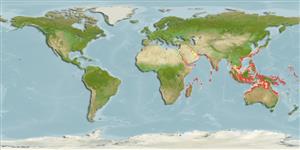Environment: milieu / climate zone / depth range / distribution range
Ecology
Marine; reef-associated; depth range 2 - 45 m (Ref. 90102). Tropical
Indo-West Pacific: Red Sea to Java (Indonesia) and the Great Barrier Reef (Australia).
Size / Weight / Age
Maturity: Lm ? range ? - ? cm
Max length : 10.0 cm TL male/unsexed; (Ref. 30404)
Dorsal
spines
(total): 6 - 7;
Dorsal
soft rays
(total): 9-10;
Anal
spines: 1;
Anal
soft rays: 8. Slender body with blotched pattern and large first dorsal, developing filaments in males (Ref. 30404); further characterized by white body color; 3-4 large brown blotches on side of body; back with smaller brown blotches; brown-edged orange spots on head; pelvic fins united medially; longitudinal scale series 49-50; mainly scaleless head, few embedded predorsal scales; greatest depth of body6.0-6.9 in SL; asymmetrically rounded caudal fin, about equal to head length (Ref. 90102).
Inhabits open sand and rubble areas adjacent to reefs (Ref. 30404, 48637). Lives with the snapping shrimp Alpheus randalli (Ref. 30404).
Life cycle and mating behavior
Maturity | Reproduction | Spawning | Eggs | Fecundity | Larvae
Randall, J.E. and M. Goren, 1993. A review of the gobioid fishes of the Maldives. Ichthyol. Bull. J.L.B. Smith Inst. Ichthyol. (58):1-37, 5 pls. (Ref. 9360)
IUCN Red List Status (Ref. 130435)
Threat to humans
Harmless
Human uses
More information
Common namesSynonymsMetabolismPredatorsEcotoxicologyReproductionMaturitySpawningSpawning aggregationFecundityEggsEgg development
ReferencesAquacultureAquaculture profileStrainsGeneticsElectrophoresesHeritabilityDiseasesProcessingNutrientsMass conversion
Tools
Special reports
Download XML
Internet sources
Estimates based on models
Preferred temperature (Ref.
123201): 25.7 - 28.6, mean 27.3 °C (based on 298 cells).
Phylogenetic diversity index (Ref.
82804): PD
50 = 0.5000 [Uniqueness, from 0.5 = low to 2.0 = high].
Bayesian length-weight: a=0.00708 (0.00333 - 0.01504), b=3.09 (2.92 - 3.26), in cm total length, based on LWR estimates for this (Sub)family-body shape (Ref.
93245).
Trophic level (Ref.
69278): 3.3 ±0.4 se; based on size and trophs of closest relatives
Resilience (Ref.
120179): High, minimum population doubling time less than 15 months (Preliminary K or Fecundity.).
Fishing Vulnerability (Ref.
59153): Low vulnerability (10 of 100).
